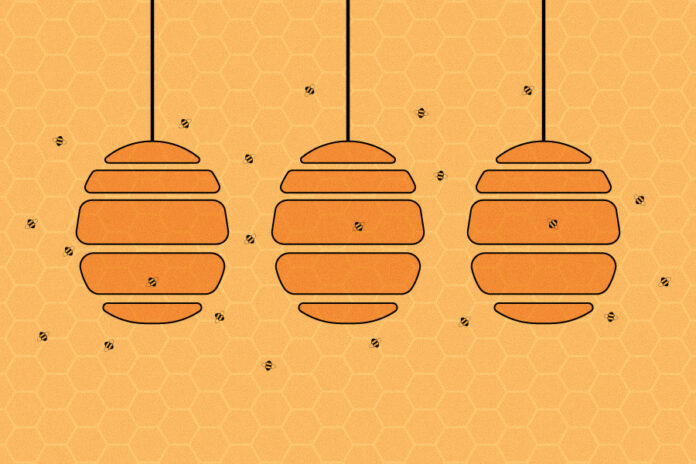Hanging bee hives provide art, functionality
Given the recent swarm of bees in Davis, Circle of Bees — a nonprofit that provides education to protect and expand beekeeping culture — has been involved in a number of projects, including an art installation that hung about 77 bee hives in Davis’ Central Park as part of a 100 Hives project. It is also working on future PolliNation Fests to facilitate more awareness about beekeeping.
Christian Coulon, the founder and president of Circle of Bees, noted that he was inspired to create a niche group that cares about bee protection and engages in more education and art surrounding beekeeping to enrich the community.
“There should be a career in city beekeeping somewhere between education and the art and science in beekeeping — there should be a rotation there,” Coulon said.
As swarms of bees come and go, John McNerney, the wildlife resource specialist for the City of Davis, clarified that swarms are inevitable.
“To be clear, swarms happen,” McNerney said via email. “There is no good reason nor feasible way to prevent them. These swarm capture devises will help control where these swarms end up colonizing. Swarms frequently establish permanent hives in precarious locations such as buildings, play structures, trees along bike paths, etc. The goal of the swam capture device installation is to offer temporary shelter to queen/ swarm until a beekeeper can collect them and give them a new, more appropriately located home. I think the blend of art and functionality is a great way to engage and educate the public about the value of honey bees and other important pollinators.”
In efforts to handle honey bee infestations, Coulon incorporated the 100 Hives project, which encompasses the arts as well as functionality through hive installations.
“100 Hives project is a practical solution to the problem of honey bee infestations in town,” Coulon said via email. “Every spring we get about 50 swarms in town which every beekeeper want. However, a good portion ends up in cavities in walls and chimneys, which nobody wants to deal with. Our swarm capture hives are built to dimensions and baited so that they are more attractive to scout bees than anything else. Therefore they prevent costly repairs and nuisance to humans and extension to bees. And we’ve had good evidence that they work because we captured 4 swarms over 4 days in Central Park last weekend while the installation was up.”
While the hives serve a function, local artists also colored and decorated them so that they are appealing to the eye. Rachel Hartsough, the City of Davis’ arts and culture manager, mentioned the city’s appreciation for the hive art installation.
“Using public art to help tell a story about environmental sustainability and stewardship is a real priority for the city’s arts program, and we are thrilled to be supporting the Circle of Bees project,” Hartsough said to The Davis Enterprise.
“Healthy bees are a vital part of our local ecology, and essential to the California economy, which relies so heavily on agricultural production,” Hartsough said to The Enterprise.
While Coulon has a vision to protect bees, Circle of Bees does not do beekeeping.
“We don’t do beekeeping,” Coulon said. “Circle of Bees is focused on visual or sensory art and education, and we saw that 100 hives could be a culmination of art and education opportunity.”
Since there is not another feasible way to prevent swarms, McNerney indicated that the swarm capture devices, or the hive art installation, is the better alternative.
“Again, there is no reasonable way to prevent this natural dispersal event,” McNerney said. “These swarm capture devices are likely the best available method to guide colony establishment.”
For future projects, Coulon noted that Circle of Bees is looking forward to future PolliNation fests, where it can throw a party for different causes.
“Examples are: Banning sale of Roundup or other toxic herbicides or fungicides in Davis, Star fest: getting the city to turn off all the lights and asking businesses and residents to do the same, for one night so that we can see the stars, [and] rallying to have the city close all of Third Street to personal automobile traffic downtown,” Coulon said.
While PolliNation Fest seems like another Whole Earth Fest, Coulon suggested its differences.
“PolliNation Fest was conceived as We have the PolliNation Fest billed as the scrappy, punky kid-sister to Whole Earth Fest, with less commercial hippy appeal and more experimental, interactive, techno-folk inclusivity,” Coulon said via email.
Written by: Stella Tran — city@theaggie.org




